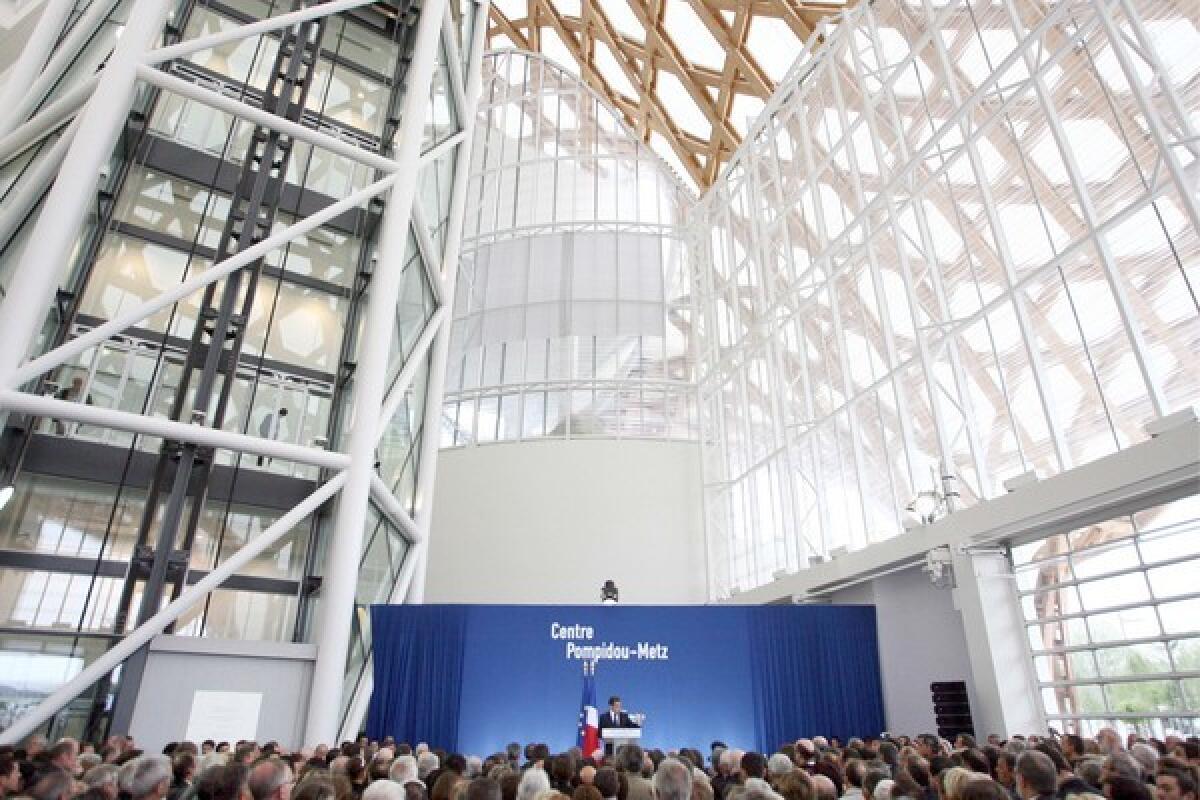Centre Pompidou-Metz exhibit explores what defines a masterpiece

Reporting from Metz, France — I came late to contemporary art. If a work wasn’t by Rembrandt or Van Gogh, I wasn’t interested. But I had friends who were, and gradually the questions asked by the artists of the last few decades hooked me. What is art? Who defines it? Should it be carefully preserved and last forever or, like an exquisite Tibetan mandala drawn with colored sand, be blown away after it’s finished?
The new Centre Pompidou-Metz contemporary art museum tries to answer these questions in its inaugural exhibition, “What Is a Masterpiece?” which runs through Oct. 25.
On a recent trip to France, I joined culture vultures from all over the world traveling to see the new wonder, which recently opened in the 2,500-year-old city of Metz.
Eighty-seven minutes from Paris by fast train, this instant icon stands like an unexpected Teflon tent anchored to the ruins of the Roman amphitheater buried beneath it. Inside is an eclectic array of art on loan from the 60,000-piece collection of Paris’ Pompidou Centre.
A paved path led me on a two-minute walk from the railroad station to the museum, designed by architects Shigeru Ban, Jean de Gastines and Philip Gumuchdjian. Beneath a steel-and-wood lattice roof covered with translucent Teflon membranes, natural light floods four floors of exhibition rooms. The museum has no permanent collection or storage space; artworks will flow in and out as special shows open and close.
A giant Matisse, “The Sadness of the King,” depicting a bizarrely abstract King David strumming his harp, greeted me in the first gallery. This art piece is relatively well known, but after that, it’s every man for himself. The exhibits are arranged in strange and wonderful ways. Installations sprout from the walls or drop from the ceiling. A life-sized Giacometti sculpture of a striding man stands next to a screen showing a film of the artist as he demonstrates with a clay miniature how he made the piece. A miniature Romanesque statue of Charlemagne floats in a white box next to a window that frames a view of 14th century St. Stephen’s Cathedral half a mile away.
I spent a long time in front of an installation called “Ben’s Shop.” Once a real store, built by a hoarder from Nice between 1958 and 1973, and crowded with objects, it’s a bright red box of treasures like some fantastical children’s playhouse. The children crowding in the doorway of the gallery were as fascinated by it as I. Art, according to Ben, is everything we see or touch and hoarding a matchstick has the same value as hanging the Mona Lisa.
The curators embrace that idea, with a diverse variety of media displayed: costumes, film, cowbells and graffiti. Everywhere I looked, my eye captured for a fleeting moment a freeze-frame of art. A passageway was not a just passageway but, when illuminated by multicolored lights, became an installation. As I looked out a window, inset into the glass was a video screen showing people looking out a window. On another screen, two men were walking through an art museum. The long, clean lines of the corridors were lighted in such a way that the people moving through them looked like walking sculpture. Casual visitors transformed, becoming abstract bodies in space, impersonating art objects.
The gallery ceilings were all angles punctuated by Alexander Calder mobiles and gigantic crystal chandeliers. Mirrors reflected the colors of the art on the walls, and a video screen stared down at me as people walked overhead. An installation of tables and chairs grew organically at right angles 10 feet above the ground. This isn’t through the looking glass, it’s wandering around inside of it, an absurd and exciting fun house of cultural whimsy.
The exhibition was a provocative maze. In a corner behind me a group of French argued furiously about a curiously carved life-size marble skeleton holding its heart in the air like a torch. It was sculpted about 1550 by Renaissance artist Ligier Richier and had been borrowed for the exhibition from the tomb of René de Châlon in Bar-le-Duc and represents the 16th century’s definition of a masterpiece.
Judging by the vocal French dueling behind me, there seemed some question about its status as a masterpiece. And what to make of Hungarian artist Gyula Halasz’s photographs? Between 1932 and 1956 he tracked down a group of urban petroglyphs hacked into the industrial concrete of Europe’s inner cities. Like Richier, 20th century taggers produced a series of skulls that Halasz’s photographs turned into art. The more art changes the more it stays the same, a lesson learned under the big top of the Pompidou-Metz.
More to Read
Sign up for The Wild
We’ll help you find the best places to hike, bike and run, as well as the perfect silent spots for meditation and yoga.
You may occasionally receive promotional content from the Los Angeles Times.






